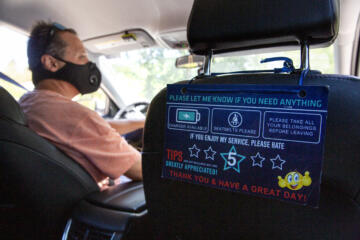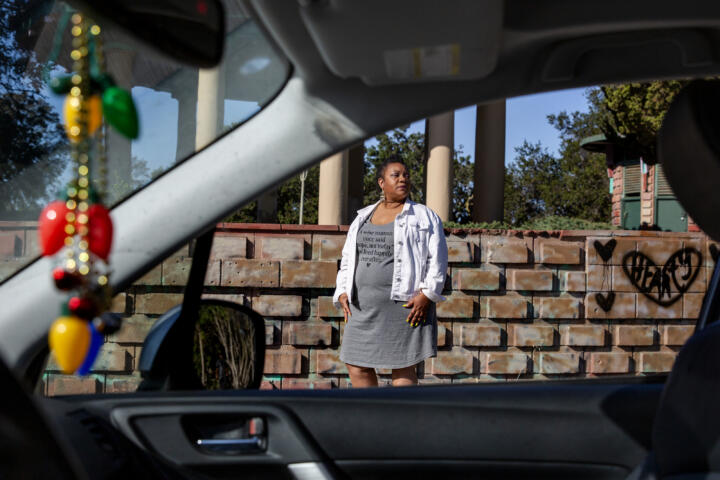Hector Castellanos has a locked-in schedule. Every Monday morning he wakes up well before sunrise to get ready for his day driving for Uber and Lyft. He’s usually on the road by 5 a.m., works nearly nonstop until about 5 p.m., goes home, sleeps, and then does it all over again every day until Saturday. On weekends, he allows himself time off.
In all, after expenses, he nets about $500 per week. It’s tiring, he said, but he has a system and it works for him. It did, that is, until a month ago, when Uber started tinkering with its app.
The tweaks are largely designed to do two things: make sure passengers get a ride when they want one and get drivers to accept more rides, including complicated or low-paying ones that they might not want. In California, where Castellanos lives, Uber removed the ability for drivers to set their own surge prices, and it changed the way it calculates its own take of the fare from a 25 percent fee to “variable.”


To Castellanos’s chagrin, Uber also stopped showing drivers information about prospective rides—like fare, destination, and distance—unless drivers have accepted five out of the last 10 offered trips. Uber first started showing that information to drivers as part of an ultimately successful $220 million ballot measure campaign in California to classify drivers as independent contractors rather than employees. Now, the company has rolled back these features in an attempt to get drivers to accept more rides.
“It’s bad,” Castellanos said. “They’re pushing us to work more.”
Uber and other ride-hail companies’ ability to deliver rides “at the push of a button” depends on having a surplus of drivers—something that’s currently in short supply as pandemic rules ease and cities start to reopen. So, the companies are also using incentives to reel in drivers. After actively blocking drivers from joining the app for months, Lyft is now offering $800 bonuses to those who return and $2,000 for new drivers in some cities. Uber has created a $250 million “stimulus” to pay out “boosted incentives and guarantees” to entice both new and veteran drivers back on the road.
Instead of incentives and guarantees, however, what many drivers say they want is simply a raise in wages—something neither company has offered.
“Even before incentives, drivers’ earnings are currently higher than normal right now as cities have started to open back up,” Kayla Whaling, an Uber spokesperson, said in an email, citing hourly wages in busy markets as ranging from $25 to $37. Kristin Chasen, a Lyft spokesperson, said Lyft is seeing the same thing and added, “To help meet the rising demand, drivers—both new and existing—are being offered incentives, which vary based on the needs of each unique market.”
These added incentives and temporary bump in hourly pay don’t help drivers in the long run though, said Marshall Steinbaum, an assistant professor of economics at the University of Utah.
“What they’re trying to do is avoid raising wages for the drivers who are already driving,” Steinbaum said. “That’s the game that they’re playing…. That shows they have lots of monopsony power.”
“Monopsony” means that one company controls an entire market. With that power, the company can dictate lower pay for labor and charge higher prices for its services or products.
With Uber and Lyft drivers scarce, passengers are seeing exorbitant fares and long wait times. Sunny Madra, vice president of Ford’s venture incubator, Ford X, tweeted last week that his Uber ride from Manhattan to John F. Kennedy airport cost $248—as much as his flight from New York to San Francisco. And WWE wrestler Alexis Kaufman tweeted that she missed her flight after scheduling three separate Uber rides, all of which were canceled. Because Uber and Lyft have all but decimated the taxi industry, it’s hard for people to hail rides that way too.
“One of our top priorities is to rebuild the driver base,” Uber CEO Dara Khosrowshahi said in an earnings call last month. “With demand currently outstripping supply, driver earnings are [at] historically elevated levels.” Similarly, Lyft chief financial officer Brian Roberts said in Lyft’s earnings call, “Demand outstripped supply, which led to elevated prices for ridesharing … and it led to record earnings for drivers in most U.S. cities.”
Drivers, however, say those expensive fares aren’t necessarily making it into their wallets. Both Uber and Lyft drivers get paid for the distance and time spent on a ride. They’ll get bonus payments when there’s a surge and high demand for rides, but most of the fares passengers pay usually go to the company. Additionally, drivers say, the labor shortage hurts them too: With fewer drivers circling around, they’re having to go farther than usual to pick up passengers, and they’re not paid for that time.
“Sometimes we have to drive 25 to 30 minutes for a pickup,” Castellanos said. “And that’s just for a five-to-10-minute ride.”
Uber has acknowledged that the bonuses, stimulus, and pricey rates are probably fleeting.
“We want drivers to take advantage of higher earnings now because this is likely a temporary situation,” Dennis Cinelli, Uber’s vice president of U.S. and Canada mobility, wrote in an April blog post. “As the recovery continues, we expect more drivers will be hitting the road, which means that over time earnings will come back to pre-Covid levels.”
Added to that, Uber and Lyft have a history of promising elusive bonuses, altering their pay models, and cutting rates for drivers.
That’s one of the issues Mekela Edwards worries about. She worked for both Uber and Lyft before the pandemic but stopped last year because she has preexisting conditions and feared contracting COVID-19 while driving.

![Mekela Edwards, a former Lyft and Uber driver, stands for a portrait outside of her <a href='https://www.logitransports.com/car-transport-company' target='_blank'>car</a> in Oakland, Calif. on Thursday, May 27, 2021. Image by Brittany Hosea-Small” width=”720″ height=”480″></figure>
<p>“There’s no guarantee about how much money I’ll earn, and that concerns me. When I first started driving, they offered those [bonuses] and then they took them away,” Edwards said. “All of this tells you that we should be paid more.”</p>
<p>Edwards said that taking this year off has allowed her to look at other options and assess whether she really wants to go back to driving, especially when drivers are so often at the mercy of the whims of the companies.</p>
<p>When asked for comment about only showing drivers trip information if they accept five of the last 10 offered rides, Whaling, Uber’s spokesperson, said, “We modified this feature because some drivers in California were declining many trip requests.” She said those declined trips contributed to 56 percent longer pickup times, and “the changes we have made are designed to resolve this issue.”</p>
<p>Castellanos feels those changes. He said that the transparency feature now seems useless since he must accept most rides. And even though some of his trips get better fares, his days are now filled hurriedly driving farther and dealing with passengers annoyed at having to wait and pay higher prices. He hasn’t been offered any bonuses from Uber, but Lyft did give him a one-time payment of $180 after he completed 90 rides.</p>
<p>When asked if he’s making better money now that the companies are touting record-high earnings, Castellanos decisively shakes his head.</p>
<p>“No,” he said. “It’s the same.”</p>
<p><em>This article by Dara Kerr was <a href=](https://cdn0.tnwcdn.com/wp-content/blogs.dir/1/files/2021/06/3s3.jpeg) originally published on The Markup and was republished under the Creative Commons Attribution-NonCommercial-NoDerivatives license.
originally published on The Markup and was republished under the Creative Commons Attribution-NonCommercial-NoDerivatives license.
